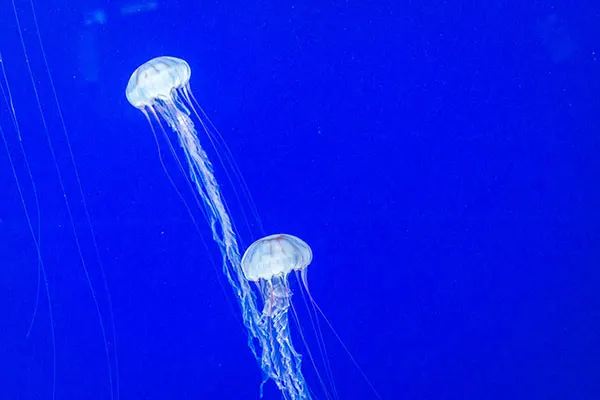One of the tragic downsides of island life is the local fauna. While some people may enjoy seeing a centipede the size of their head, for most of us these creatures are best avoided.
Don’t worry, there aren’t many animals on Maui that pose a serious danger.
Creatures can be creepy, not threatening. But to stay safe, you have to know the difference between what you might want to avoid, and what you need to stay away from.
Dangerous Animals In The Sea
Table of Contents
While dolphins and sea turtles get all the attention, box jellyfish and cone snails are what you need to keep an eye out for in Maui.
The best protection is to be sensible.
Avoid touching anything, and if someone tells you to stay out of the water, stay out of the water.
Box Jellyfish
The box jellyfish is the biggest danger to be found on Maui. Growing up to 10 feet long and covered in venomous barbs, an encounter with a box jellyfish can be potentially fatal.
On the busiest beaches of Maui lifeguards keep watch, and the beach will be closed if a box jellyfish is spotted close to the shore.
Cone Snails
Yes, a snail is one of the most dangerous of Maui creatures. Cone snails are underwater creatures that look very pretty, with colorful shells that at first glance seem like a great souvenir.
But don’t touch!
Not all cone snails are dangerous, but those that are can cause fatalities. Best to avoid them altogether.
Tiger Sharks
Shark attacks are very rare, but these majestic creatures do spend time in the waters of Maui.
Sharks don’t attack without provocation, so be sure to treat them with respect.
Yellow Bellied Sea Snake
The yellow-bellied sea snake is an invader in the seas of Maui, and its venomous bite can be harmful.
They’re very rare, as even scientists looking for the yellow-bellied sea snake hardly find them.
But, if you’re swimming and you spot a snake, start swimming in the other direction.
Dangerous Animals On Land
Maui doesn’t have bears, big cats, or even monkeys.
Most of the creatures you come across on land are not harmful, although an aggravated goose may suggest otherwise.
Even if you’re heading into the wilderness, there’s little worry about attack. (Apart from some creepy crawlies, which we’ll get to later.)
Although staying away from most animals isn’t necessary for your safety, it is better for the safety of the animals. Visitors bring bacteria and infections with them that can be life-threatening to local species, so keep your hands to yourself!
Brown Tree Snake (And Other Snakes)
There are no snakes native to Hawaii but there are a few invasive snakes.
The brown tree snake is one of these more established populations, and their bite can be fatal for children. You’re very unlikely to come across a brown tree snake, but it’s still worth being aware of.
Dangerous Insects And Other Creepy Crawlies
Why do the loveliest places always seem to have the most horrifying insects? It’s the price that has to be paid for gorgeous weather and abundant flora.
And if we love to spend our time on Maui, who can blame the insects for feeling the same way?
For the most part, insects on Maui can be big and terrifying, but not very dangerous.
However, there are some that pair scary looks with fearsome bites.
The Giant Centipede
The giant centipede can grow to 12 inches and likes to attack everything it sees—that includes humans. These centipedes will happily try to eat mice and lizards, and will bite anything that they perceive as in the way.
They don’t like the heat, preferring to hunt at night, and tend to be found in dark and moist areas.
Giant centipedes are also a fan of sleeping bags, so be sure to check the ground if you go camping.
A centipede bite is painful, but won’t cause any lasting harm. The horror of finding a giant centipede in your sleeping bag lasts much longer.
Red Velvet Ant
“Ant” is a misnomer. The red velvet ant is a wasp that can grow up to an inch long, and packs a mean sting, but it’s only the flightless females that sting.
However, the sting isn’t fatal, and the pain tends to fade after 30 minutes.
Their bright red stripes act as a good deterrent for curious humans.
Brown Violin Spider (Or The Brown Recluse Spider)
A bite from a brown recluse spider is potentially fatal, but these small creatures prefer to keep to themselves.
Brown and spindly, they like to hide in dark corners. Bites only happen as a last resort if the spider is nervous, so if you spot a brown violin spider, just back away and leave them alone.
Black Widow Spider
Small, black, and with a warning red hourglass pattern, the black widow spider is incredibly toxic. At least, the females are.
They prefer to stay in their webs in the corners of gardens and fields, and let their prey come to them.
How Dangerous Is It?
Maui isn’t known for its dangerous animals, with even trips into the country likely to result in nothing more than a slight shock from a large insect.
However, it is important to be careful at all times, and especially when in the sea. Treat the creatures with respect, and they tend to leave you alone. This is also important on land, where diseases left by visitors have hurt local wildlife populations.
If you do come across something terrifying, we recommend backing away slowly, and warning others. A visit to the Ho’okipa beach turtles may be necessary to wipe any lingering fears from your mind.

